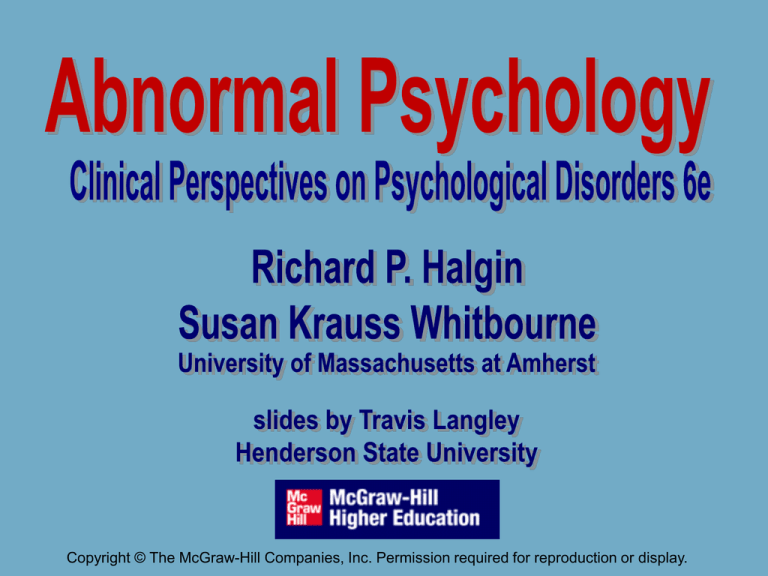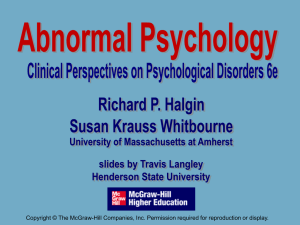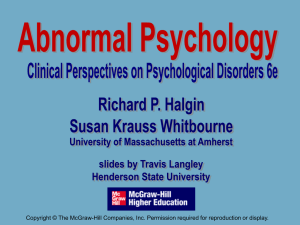Chapter 9
advertisement

Abnormal Psychology Clinical Perspectives on Psychological Disorders 5e Richard P. Halgin Susan Krauss Whitbourne University of Massachusetts at Amherst slides by Travis Langley Henderson State University Copyright © The McGraw-Hill Companies, Inc. Permission required for reproduction or display. Chapter 1 Copyright © The McGraw-Hill Companies, Inc. Permission required for reproduction or display. Schizophrenia A disorder with a range of psychotic symptoms involving disturbances in content of thought, form of thought, perception, affect, sense of self, motivation, behavior, and interpersonal functioning. Copyright © © The Companies, Inc. Inc. Permission Permissionrequired requiredfor for reproduction reproduction or or display. display. Copyright The McGraw-Hill McGraw-Hill Companies, Bleuler coined the term schizophrenia. Bleuler The four fundamental features are still referred to as Bleuler’s Four A’s: Association (thought disorder) Affect (emotional disturbance) Ambivalence (inability to make or follow through on decisions) Autism (idiosyncratic style of egocentric thought and behavior) Copyright © The McGraw-Hill Companies, Inc. Permission required for reproduction or display. Phases of Schizophrenia Active Prodromal Residual Copyright © © The Companies, Inc. Inc. Permission Permissionrequired requiredfor for reproduction reproduction or or display. display. Copyright The McGraw-Hill McGraw-Hill Companies, Schizophrenic Symptoms Disturbances can be seen in . . . Perception Hallucinations Thoughts Lack cohesiveness and logic Language Incomprehensibility Actions Odd and disturbing Copyright © © The Companies, Inc. Inc. Permission Permissionrequired requiredfor for reproduction reproduction or or display. display. Copyright The McGraw-Hill McGraw-Hill Companies, Schizophrenic Symptoms Positive symptoms: Exaggerations or distortions of normal thoughts, emotions, and behavior. Negative symptoms: Symptoms that involve functioning below the level of normal behavior. Copyright © © The Companies, Inc. Inc. Permission Permissionrequired requiredfor for reproduction reproduction or or display. display. Copyright The McGraw-Hill McGraw-Hill Companies, Schizophrenic Symptoms delusions affective flattening hallucinations alogia disturbed speech avolition disturbed behavior anhedonia Copyright © © The Companies, Inc. Inc. Permission Permissionrequired requiredfor for reproduction reproduction or or display. display. Copyright The McGraw-Hill McGraw-Hill Companies, Types of Schizophrenia Characterized by at least two bodily movement abnormalities: Motor immobility or stupor Purposeless motor activity Mutism or extreme negation Peculiarities of movement or odd mannerisms and grimacing Echolalia or echopraxia Copyright © The McGraw-Hill Companies, Inc. Permission required for reproduction or display. Types of Schizophrenia Characterized by a combination of symptoms, including disorganized speech and behavior and flat or inappropriate affect. Even delusions and hallucinations lack a coherent theme. Copyright © The McGraw-Hill Companies, Inc. Permission required for reproduction or display. Types of Schizophrenia Characterized by preoccupation with one or more bizarre delusions, or with auditory hallucinations that are related to a particular theme of being persecuted or harassed. Without disorganized speech or disturbed behavior. Copyright © The McGraw-Hill Companies, Inc. Permission required for reproduction or display. Types of Schizophrenia Characterized by a complex of schizophrenic symptoms that does not meet the criteria for other types of schizophrenia. Copyright © The McGraw-Hill Companies, Inc. Permission required for reproduction or display. Types of Schizophrenia Applies to people previously diagnosed as schizophrenic if they no longer show prominent psychotic symptoms but still show lingering signs of the disorder. Copyright © The McGraw-Hill Companies, Inc. Permission required for reproduction or display. Dimensions of Schizophrenia Alternate three-factor model: 1. Psychotic 2. Negative 3. Disorganized Copyright © The McGraw-Hill Companies, Inc. Permission required for reproduction or display. Courses of Schizophrenia Continuous Recurring episodes Single episode Copyright © The McGraw-Hill Companies, Inc. Permission required for reproduction or display. Factors Associated With More Favorable Prognosis Good premorbid functioning Acute onset Later age at onset Good insight Being female Consistent in medication usage Brief active-phase symptoms Good functioning between episodes Absence of structural brain abnormalities Normal neurological functioning No family history of schizophrenia Copyright © The McGraw-Hill Companies, Inc. Permission required for reproduction or display. Other Psychotic Disorders Copyright © The McGraw-Hill Companies, Inc. Permission required for reproduction or display. The schizophrenia-like disorders share three features: 1. Serious break with reality 2. Not caused by cognitive impairment 3. Not primarily affective Copyright © The McGraw-Hill Companies, Inc. Permission required for reproduction or display. Brief Psychotic Disorder • with marked stressor(s), • without marked stressor(s), or • with postpartum onset A disorder characterized by the sudden onset of psychotic symptoms that are limited to a period of less than a month. Copyright © The McGraw-Hill Companies, Inc. Permission required for reproduction or display. Schizophreniform Disorder A disorder with essentially the same symptoms as schizophrenia, but that lasts less than 6 months (and more than 1). Copyright © The McGraw-Hill Companies, Inc. Permission required for reproduction or display. Schizoaffective Disorder Schizophrenia with co-occurring mood disorder. Copyright © The McGraw-Hill Companies, Inc. Permission required for reproduction or display. Delusional Disorders People with delusional disorders have a single striking psychotic symptom: an organized system of nonbizarre false beliefs. Copyright © The McGraw-Hill Companies, Inc. Permission required for reproduction or display. Delusional Disorders People with delusional disorders have a single striking psychotic symptom: an organized system of nonbizarre false beliefs. Erotomanic Somatic Persecutory Grandiose Jealous Copyright © The McGraw-Hill Companies, Inc. Permission required for reproduction or display. Shared Psychotic Disorder In shared psychotic disorder, the person develops a delusional system as a result of a close relationship with a psychotic person who is delusional. Intervention calls for: • Separating them. • Focusing on personal issues related to this person’s vulnerability to being dominated. • Bolstering the client’s self-esteem. Copyright © The McGraw-Hill Companies, Inc. Permission required for reproduction or display. Biological Theories Brain Structure and Function Cortical atrophy Reduced brain activation Dopamine hypothesis Possible serotonin deficit Lines of Evidence for Dopamine Hypothesis Antipsychotic medications Effects of drugs like amphetamines Copyright © The McGraw-Hill Companies, Inc. Permission required for reproduction or display. Biological Theories endophenotypes biobehavioral abnormalities linked to genetic and neurobiological causes of mental illness In other words, they are heritable traits or characteristics that are not direct symptoms of the disorder but have been found to be associated. Copyright © The McGraw-Hill Companies, Inc. Permission required for reproduction or display. Biological Theories Three measures of cognitive functioning stand out as particularly important in the search for biological markers: Sustained attention Smooth pursuit eye movements Antisaccade eye movements Copyright © The McGraw-Hill Companies, Inc. Permission required for reproduction or display. Psychological Perspective No credible theory proposes that schizophrenia develops exclusively as the result of psychological phenomena. Copyright © The McGraw-Hill Companies, Inc. Permission required for reproduction or display. Psychological Perspective However, behavioral psychologists have found factors influencing whether the likelihood the schizophrenic individual will act in a “normal” way or not. Copyright © The McGraw-Hill Companies, Inc. Permission required for reproduction or display. Psychological Perspective Failure to learn important social cues. Lack of attention from others. Retreat into fantasy world. Behaviors become odd and eccentric. Being labeled as odd or schizophrenic. Hospitalization exacerbates maladaptive behaviors. Copyright © The McGraw-Hill Companies, Inc. Permission required for reproduction or display. Sociocultural Perspective Focus on the Family System Faulty modes of behavior and communication High degree of expressed emotion Cognitive distortions Social Class and Income Onset may be associated with environmental stressors of poverty. Contracting the disease leads to social and economic “downward drift.” Copyright © The McGraw-Hill Companies, Inc. Permission required for reproduction or display. Biological Treatment Neuroleptics Vary in potency All block dopamine receptors Side effects: Tardive dyskinesia Compromise of immune system Copyright © The McGraw-Hill Companies, Inc. Permission required for reproduction or display. Psychosocial Treatment Psychological Token economy Social skills training Cognitive behavioral techniques Sociocultural Milieu therapy Family therapy Biopsychosocial Approach Copyright © The McGraw-Hill Companies, Inc. Permission required for reproduction or display. For more information on material covered in this chapter, visit our Web site: http:/www.mhhe.com/halgin6e Copyright © The McGraw-Hill Companies, Inc. Permission required for reproduction or display.








